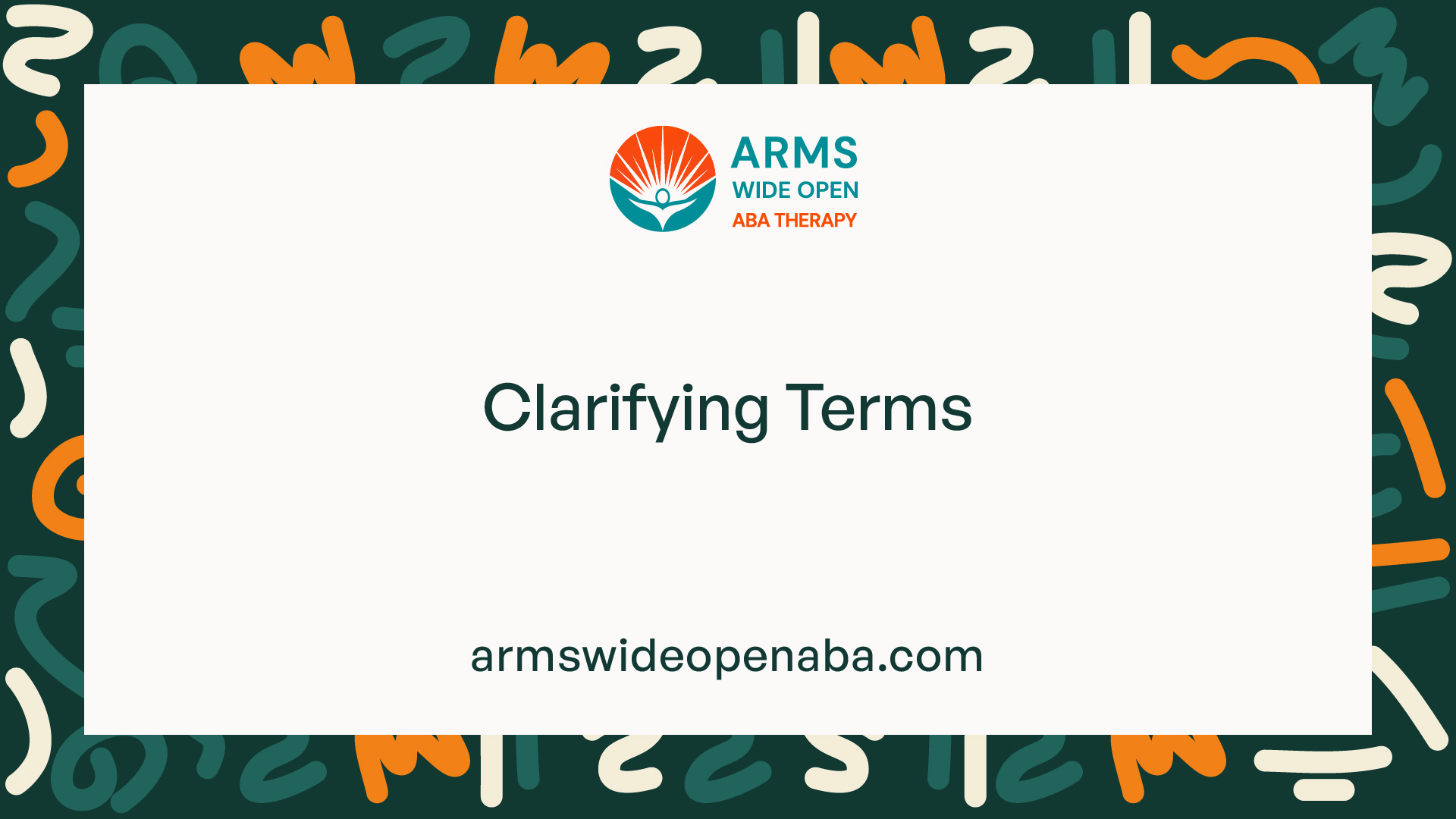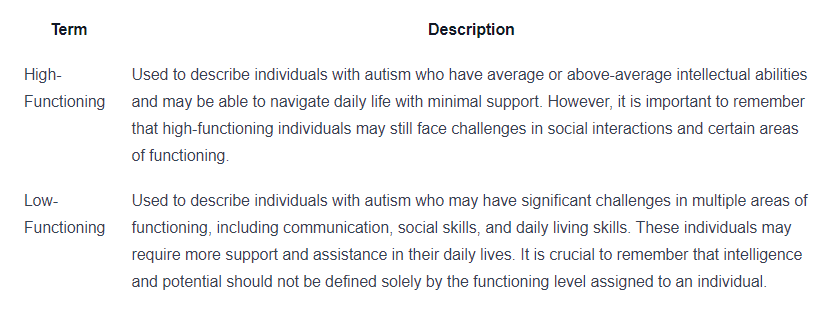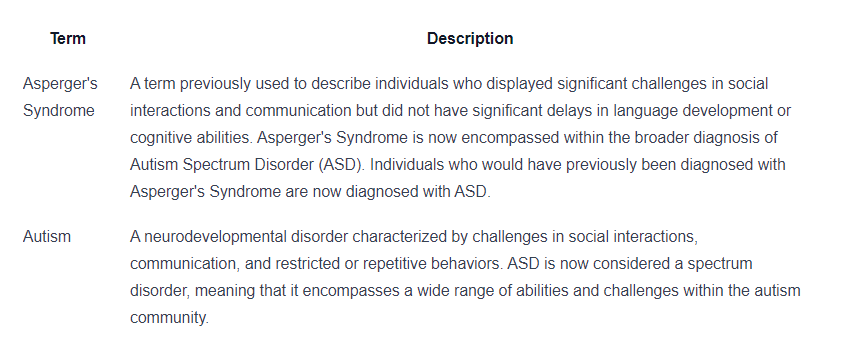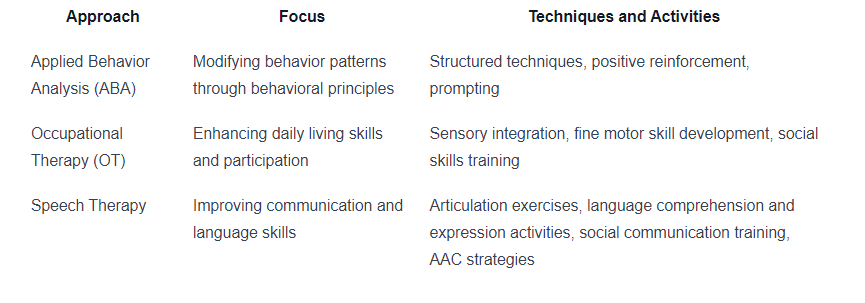Autism Terms You May Be Misunderstanding
Don't get lost in the jargon! Understand misunderstood autism terms to support inclusivity and awareness.


Demystifying Autism Terms
Autism Spectrum Disorder (ASD) is a complex neurological condition that affects individuals in various ways. To better understand this condition, it's important to clarify some commonly misunderstood terms associated with autism.
Understanding Autism Spectrum Disorder
Autism Spectrum Disorder is a developmental disorder characterized by difficulties in social interaction, communication, and repetitive behaviors. It is called a "spectrum" disorder because the symptoms and severity can vary widely from person to person. Some individuals with ASD may have exceptional abilities in certain areas, while others may face significant challenges in daily life.
To provide a clearer understanding, here are some key features of Autism Spectrum Disorder:
Key Features
Impairments in social interaction and communication
Restricted and repetitive behaviors, interests, or activities
Sensory sensitivities
Differences in processing information and learning
Unique strengths and challenges
Common Misconceptions
There are several misconceptions surrounding autism that can contribute to misunderstandings and stereotypes. It's important to address these misconceptions to promote accurate information and support individuals with autism. Here are a few common misconceptions:
Misconceptions
Autism is caused by bad parenting or vaccines.
All individuals with autism are nonverbal.
Autism can be cured.
People with autism lack empathy.
Autism only affects children.
By understanding the true nature of Autism Spectrum Disorder and dispelling common misconceptions, we can create a more inclusive and supportive environment for individuals with autism. It's important to approach autism with compassion, empathy, and a willingness to learn and accommodate the unique needs of each individual.

Clarifying Terms
When it comes to understanding autism, there are several terms that are often misunderstood. In this section, we will clarify the meanings of high-functioning vs. low-functioning, Asperger's Syndrome vs. Autism, and Sensory Processing Disorder.
High-Functioning vs. Low-Functioning
The terms "high-functioning" and "low-functioning" are used to describe the level of support an individual with autism may need. However, it is important to note that these terms can be oversimplifications and may not fully capture the complexities of autism.

Asperger's Syndrome vs. Autism
In the past, Asperger's Syndrome was considered a separate diagnosis from Autism Spectrum Disorder (ASD). However, according to the current diagnostic criteria, Asperger's Syndrome is no longer recognized as a separate diagnosis but is now considered to be on the autism spectrum.

Sensory Processing Disorder
Sensory Processing Disorder (SPD) is a condition that can coexist with autism but is not exclusive to individuals on the autism spectrum. It is important to understand that SPD and autism are separate conditions, although they may often occur together.

By clarifying these terms, we can foster a better understanding of autism and the challenges individuals on the spectrum may face. It is important to approach these terms with sensitivity and recognize the unique experiences and strengths of each individual.

Exploring Communication
Effective communication is a vital aspect of understanding and supporting individuals with autism. In this section, we will explore three terms related to communication in the context of autism: nonverbal, minimally verbal, echolalia, and social pragmatic communication disorder (SPCD).
Nonverbal vs. Minimally Verbal
The terms "nonverbal" and "minimally verbal" are often misunderstood when discussing autism. Nonverbal individuals with autism have significant difficulties using spoken language to communicate their wants, needs, and thoughts. They may rely on alternative forms of communication, such as sign language, picture communication systems, or assistive technology.
On the other hand, individuals who are minimally verbal have limited verbal communication skills and may use only a few words or short phrases. They may also rely on alternative communication methods to supplement their verbal language.
Understanding the distinction between nonverbal and minimally verbal individuals is essential for providing appropriate support and interventions tailored to their specific communication needs.
Echolalia
Echolalia is a common communication behavior observed in individuals with autism. It refers to the repetition of words or phrases spoken by others. There are two types of echolalia: immediate and delayed.
Immediate echolalia involves repeating words or phrases immediately after hearing them, often without comprehension of their meaning. It can serve as a way for individuals with autism to process and practice language.
Delayed echolalia, on the other hand, involves the repetition of previously heard words or phrases at a later time. It can be a way for individuals to express themselves, answer questions, or communicate their needs and preferences.
It's important to note that echolalia can serve various functions and should not be dismissed as meaningless repetition. It can provide valuable insights into an individual's comprehension and communication abilities.
Social Pragmatic Communication Disorder (SPCD)
Social Pragmatic Communication Disorder (SPCD) is a term used to describe individuals who have significant challenges with social communication skills, but do not meet the criteria for an autism spectrum disorder (ASD) diagnosis. These individuals may struggle with understanding and using verbal and nonverbal cues, engaging in reciprocal conversations, and interpreting social situations accurately.
SPCD is characterized by difficulties in the social use of communication and may impact an individual's ability to form and maintain relationships, participate in social interactions, and navigate social contexts effectively.
It's important to recognize that individuals with SPCD require support and interventions tailored to their specific communication challenges, just like individuals with autism spectrum disorder.
Understanding these terms related to communication in the context of autism can contribute to better communication and support for individuals on the autism spectrum. By acknowledging and respecting different communication styles and needs, we can create a more inclusive and understanding environment for individuals with autism.
Behavioral Terminology
Understanding the behavioral terminology associated with autism is essential for promoting understanding and empathy. In this section, we will clarify the meanings of several commonly misunderstood terms: meltdown vs. tantrum, stimming, and scripting.
Meltdown vs. Tantrum

Differentiating between meltdowns and tantrums is crucial, as it helps to avoid misconceptions and provide appropriate support and understanding for individuals with autism.
Stimming
Stimming, short for self-stimulatory behavior, refers to repetitive movements or actions that individuals with autism engage in to self-regulate or self-soothe. These behaviors can vary widely and may include hand flapping, rocking, spinning, finger flicking, or vocal sounds.
Stimming serves a purpose for individuals with autism, helping them cope with sensory overload, reduce anxiety, or express excitement. It is important to note that stimming is a natural and necessary way for individuals with autism to regulate their emotions and sensory experiences.
While stimming can sometimes be seen as socially inappropriate or disruptive, it is essential to understand that suppressing stimming behaviors entirely can be detrimental to an individual's well-being. Instead, providing alternative outlets for stimming, such as fidget toys or designated spaces, can be beneficial in allowing individuals with autism to self-regulate in a more socially acceptable manner.
Scripting
Scripting refers to the repetition of words, phrases, or dialogue from movies, books, or previous conversations. Individuals with autism may engage in scripting as a form of communication, self-soothing, or to navigate social situations. Scripting can take the form of echolalia, where individuals repeat words or phrases immediately after hearing them, or it can involve the use of pre-learned scripts to initiate or maintain conversations.
Scripting serves as a way for individuals with autism to navigate social interactions and express themselves, especially when faced with difficulties in spontaneous language production or understanding social cues. While it may appear unusual or out of context to others, it is important to recognize that scripting plays a valuable role in communication for individuals with autism.
By understanding and appreciating these behavioral terms associated with autism, we can foster greater acceptance and support for individuals on the autism spectrum. It is crucial to approach these terms with empathy and avoid misconceptions, allowing us to create inclusive environments that celebrate the unique experiences and strengths of individuals with autism.
Support and Interventions
When it comes to supporting individuals with autism spectrum disorder (ASD), there are various interventions and therapies available. These interventions aim to improve communication, social skills, and overall quality of life for individuals on the spectrum. In this section, we will explore three commonly used support and intervention approaches: Applied Behavior Analysis (ABA), Occupational Therapy (OT), and Speech Therapy.
Applied Behavior Analysis (ABA)
Applied Behavior Analysis (ABA) is a widely recognized and evidence-based approach for supporting individuals with autism. ABA therapy is focused on understanding and modifying behavior patterns through the application of behavioral principles and strategies. It aims to teach new skills, reduce challenging behaviors, and promote positive behaviors.
ABA therapy typically involves the use of structured techniques to break down skills into smaller, manageable steps. These techniques may include positive reinforcement, prompting, and systematic prompting. ABA therapy sessions are tailored to the individual's specific needs and may be conducted in various settings, such as home, school, or therapy centers.
Occupational Therapy (OT)
Occupational Therapy (OT) is another valuable intervention for individuals with autism. OT focuses on improving and enhancing an individual's ability to engage in daily activities and routines. The goal is to develop skills necessary for independent living, self-care, and participation in school, work, and social settings.
In OT sessions, therapists use various techniques and activities to address sensory, motor, and cognitive challenges that individuals with autism may face. These interventions may include sensory integration activities, fine motor skill development, and social skills training. OT can help individuals with autism develop better self-regulation, sensory processing, and adaptive skills.
Speech Therapy
Speech Therapy, also known as Speech-Language Pathology, plays a crucial role in supporting individuals with autism who may have difficulties with communication and language skills. Speech therapists work with individuals to improve their speech, language, and social communication abilities.
Speech therapy sessions may involve a variety of techniques and activities tailored to the individual's needs. These may include articulation exercises, language comprehension and expression activities, social communication training, and augmentative and alternative communication (AAC) strategies.
Here is a table summarizing some key aspects of these support and intervention approaches:

These support and intervention approaches should be implemented in collaboration with a team of professionals, including therapists, educators, and caregivers. The combination of these interventions can provide individuals with autism the necessary tools and skills to navigate the challenges they may encounter and achieve their full potential.
Sources
https://www.verywellhealth.com/common-autism-terms-you-may-be-misunderstanding-4058516
https://www.autismparentingmagazine.com/autism-speech-patterns/
Similar articles
We’re here to help you

Our team is here to assist you in this process. Contact us for any assistance.
it’s easy to apply
We Accept Most Insurances
Our in-network insurance partnerships make ABA therapy more accessible to families throughout our service areas.







Our Insurance Process
We'll request your insurance details to help us verify your plan's coverage for ABA therapy. Once we've received this information, we'll walk you through your benefits, including copayments, deductibles and out-of-pocket maximums, so you know what to expect in advance.
Our team will then handle the preauthorization and all the necessary paperwork.
.svg)





















.jpeg)


































.jpeg)




.jpeg)







.jpeg)











.jpeg)
















